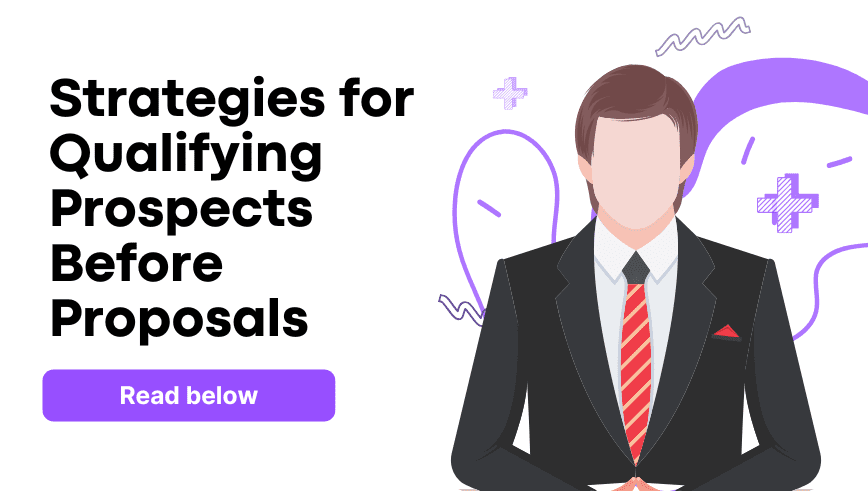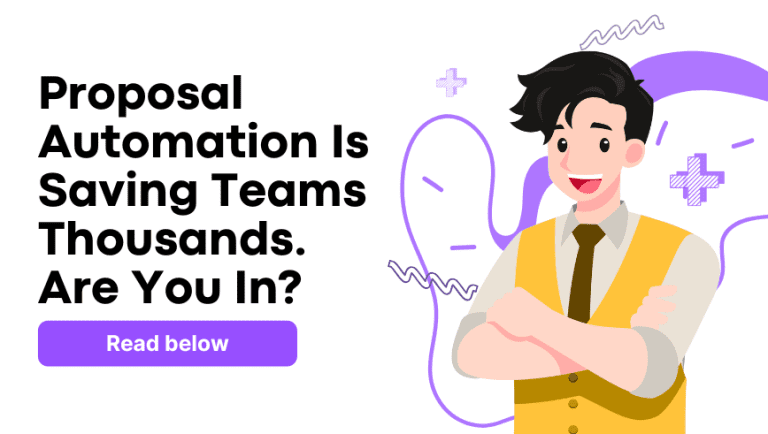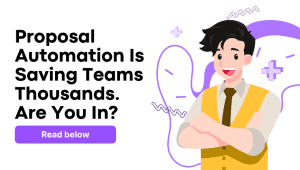Nous sommes tous passés par là… investir des heures dans une proposition qui n'aboutit jamais. C'est frustrant, chronophage et une perte d'énergie totale. Mais imaginez si vous pouviez qualifier vos prospects avant même de commencer à rédiger. Et s'il existait une stratégie vous garantissant de ne consacrer votre temps qu'aux prospects prêts à convertir ? Voilà le pouvoir des stratégies de proposition avant-vente.
Si vous envisagez des outils pour automatisez votre processus de propositionVous vous sentez probablement dépassé. Il existe de nombreuses options, et il est difficile de savoir laquelle correspond à vos besoins. Vous n'êtes pas seul. De nombreuses entreprises sont confrontées au même défi. C'est pourquoi il est si important de comprendre le processus de rédaction d'une proposition avant-vente. En qualifiant les prospects dès le début, vous vous assurez que, lorsque vous rédigez une proposition, elle s'adresse à un prospect sérieux.
Il existe cependant un processus à suivre pour qualifier les prospects avant de rédiger des propositions et optimiser votre cycle de vente. Nous aborderons également la différence entre les propositions avant-vente et les propositions finales, et comment cette stratégie peut vous faire gagner du temps, de l'argent et vous éviter des frustrations.
Qu'est-ce que le processus de pré-proposition ?
Au cœur de la stratégie de proposition avant-vente se trouve la qualification des prospects avant la rédaction de la proposition. Au lieu de se lancer directement dans la rédaction de propositions détaillées, les entreprises doivent d'abord recueillir les informations clés qui les aideront à déterminer si le prospect mérite d'être poursuivi.
Cela implique un travail de découverte important : dialoguer avec le prospect, comprendre ses besoins, évaluer son budget et déterminer s'il est réellement prêt à passer à l'action. En prenant le temps de qualifier le prospect, vous vous assurez de ne pas investir dans une proposition pour un prospect qui ne se convertira pas.
La phase d'avant-vente implique une collaboration entre les équipes commerciales et techniques, afin de s'assurer que votre solution répond aux besoins du prospect. Que vous vendiez un produit ou un service, cette phase vise à comprendre les difficultés de votre prospect avant de passer à la proposition formelle.
Comment qualifier les prospects avant de rédiger une proposition
La clé d'une proposition avant-vente réussie réside dans la qualification précoce de vos prospects. Vous devez vous assurer de ne pas perdre de temps à rédiger des propositions pour des acheteurs peu sérieux. Alors, comment savoir si un prospect est prêt à recevoir une proposition ?
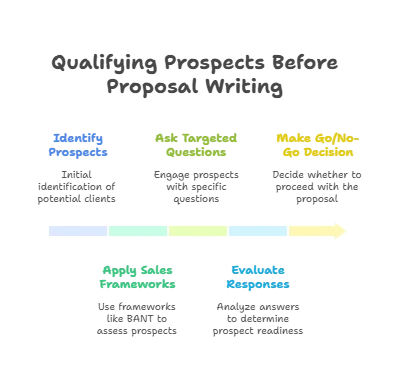
1. Utiliser les cadres de qualification des ventes
L'utilisation de cadres de qualification commerciale tels que BANT, MEDDIC et CHAMP peut vous aider à évaluer si le prospect mérite réellement votre attention. C'est un élément essentiel de votre stratégie. stratégie de venteCes cadres posent des questions spécifiques pour vous aider à évaluer l'état de préparation du prospect. Par exemple :
BANT:
– Budget: Le prospect dispose-t-il du budget nécessaire pour effectuer un achat ?
– Autorité: Parlez-vous avec le décideur ?
– Besoin: Existe-t-il un réel besoin pour votre solution ?
– Timing: Existe-t-il un sentiment d’urgence quant à la résolution du problème ?
En évaluant ces quatre éléments dès le début, vous pouvez filtrer les prospects qui ne sont pas sérieux dans leur intention d’achat.
2. Posez des questions ciblées
Lors de la phase de découverte, poser des questions ciblées est essentiel pour comprendre les difficultés de votre prospect. Voici quelques questions importantes à poser :
– Quels résultats espérez-vous obtenir avec cette solution ?
– Comment relevez-vous actuellement ces défis ?
– Qui est impliqué dans le processus de prise de décision ?
– Quel est votre délai pour prendre une décision ?
Ces questions vous aideront à déterminer si le prospect souhaite sérieusement aller de l’avant ou s’il explore simplement des options.
3. Critères de décision d'approbation ou de refus
L'objectif est de prioriser les bons leads. Si un prospect correspond à vos critères de qualification, il vaut la peine de poursuivre. En revanche, s'il ne les remplit pas, mieux vaut consacrer votre temps à quelqu'un qui a plus de chances de se convertir.
Comment éviter de perdre du temps avec des prospects non qualifiés
Personne ne souhaite passer des heures à rédiger une proposition pour finalement découvrir que le prospect n'était pas prêt ou n'avait même pas besoin de votre solution. Alors, avant de commencer à réfléchir, réfléchissez comment rédiger votre proposition commerciale, vous devez d'abord identifier si les prospects sont même admissibles pour que vous en écriviez un :

1. Comprendre le problème avant de proposer une solution
Avant de vous lancer dans une proposition, il est essentiel de bien comprendre le problème de votre prospect. Vous devez évaluer si son défi justifie la solution que vous lui proposez. S'il ne rencontre pas de problème que votre solution peut résoudre, mieux vaut passer à autre chose.
2. Concentrez-vous sur les prospects à forte valeur ajoutée
Au lieu de ratisser large et de rédiger des propositions pour chaque prospect, concentrez vos efforts sur les prospects à forte valeur ajoutée. Ce sont ceux qui répondent à vos critères et manifestent un réel intérêt pour votre solution. En privilégiant ces prospects à forte valeur ajoutée, vous vous assurez que vos propositions parviennent à des personnes plus susceptibles de conclure une transaction.
3. Recherchez les signaux d'intention sérieuse
Un prospect sérieux montrera qu'il est prêt à aller de l'avant. Il engagera des conversations plus approfondies, posera des questions précises et se montrera disposé à voir des propositions ou des démonstrations détaillées. Si un prospect ne montre pas ces signes, il ne mérite peut-être pas votre attention.
Qu'est-ce qui rend les propositions de prévente uniques ?
Bien que toutes les propositions soient présentées avant la vente, les propositions d'avant-vente sont uniques car elles répondent à un objectif différent. Elles servent à positionner votre solution et à évaluer l'adéquation avec le prospect. Contrairement aux propositions finales, détaillées et juridiquement contraignantes, les propositions d'avant-vente sont flexibles et visent davantage à engager la conversation.
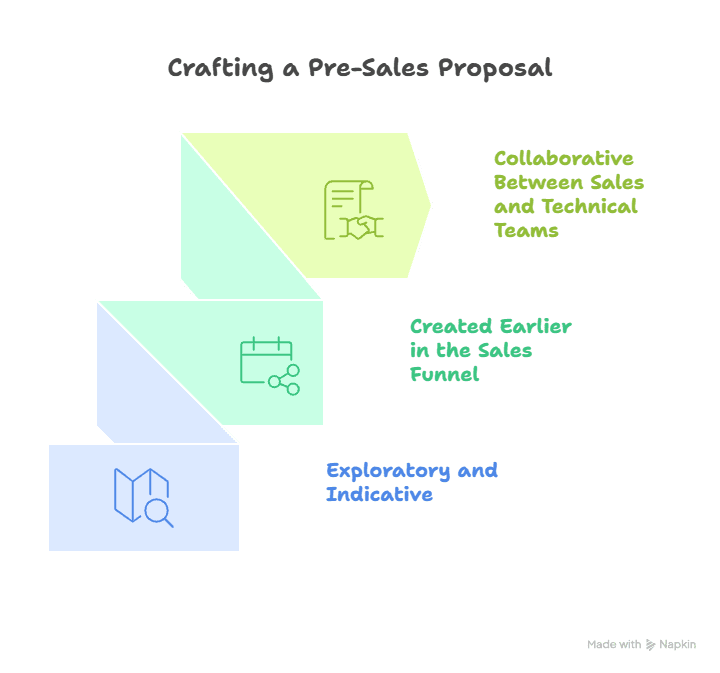
1. Exploratoire et indicatif
Une proposition avant-vente vise à déterminer si votre solution est adaptée. Il ne s'agit pas de finaliser tous les détails, mais plutôt de montrer au prospect comment votre produit ou service peut répondre à ses besoins. Ces propositions contribuent à faire avancer la conversation et à susciter l'intérêt.
2. Créé plus tôt dans l'entonnoir de vente
La proposition de prévente intervient souvent plus tôt dans le processus. cycle de vente, avant un appel d'offres ou même la première réunion formelle. À ce stade, vous êtes encore en phase de découverte, et l'objectif est d'informer le prospect et de lui montrer comment vous pouvez résoudre ses problèmes. Il s'agit de préparer le terrain pour la proposition formelle qui suivra.
3. Collaboration entre les équipes commerciales et techniques
Étant donné que vous positionnez votre solution, il est important de collaborer avec votre équipe technique pour garantir la faisabilité de votre proposition et répondre aux besoins techniques du prospect. Cette collaboration vous garantit de ne pas faire de promesses impossibles à tenir.
Propositions de vente avant-vente et propositions de vente finales
Il est essentiel de distinguer les propositions avant-vente des propositions finales. Voici la différence :
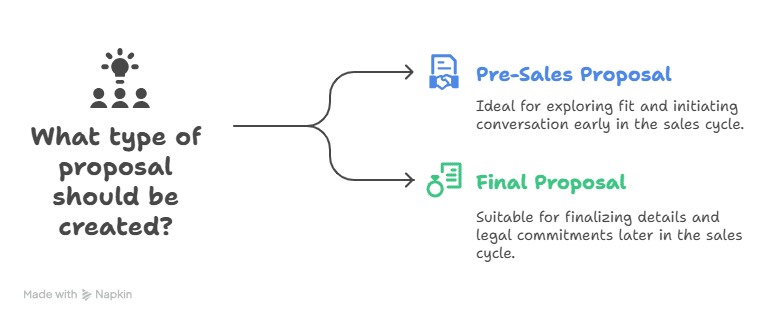
– Proposition avant-vente : Il s'agit d'un document exploratoire. Il vous aide à positionner votre solution et à déterminer si le prospect correspond à vos attentes.
– Proposition finale : Une proposition finale est plus détaillée et définitive. Elle décrit les prix, les livrables et les délais spécifiques.
La proposition finale est souvent juridiquement contraignante, tandis que la proposition de prévente vise davantage à lancer la conversation.
L'impact de la stratégie de proposition avant-vente sur le taux de clôture des ventes
En qualifiant les prospects dès le début du processus de vente, les entreprises augmentent leurs chances de conclure des affaires. Ce n'est pas tout : une étude de Hubspot suggère que l'utilisation des outils d'IA est bénéfique. augmente la productivité de 73% au sein des équipes commerciales. La stratégie de proposition avant-vente permet aux équipes commerciales de se concentrer uniquement sur les prospects sérieux, ce qui conduit à un taux de clôture des ventes plus élevé et meilleur retour sur investissementCela réduit également les risques de perdre du temps sur des transactions qui n’auraient jamais pu être conclues.
Défis courants dans la stratégie de proposition avant-vente et comment les surmonter
La mise en œuvre d’une stratégie de proposition avant-vente semble simple, mais il existe quelques obstacles courants :
– Informations incomplètes : Il peut être difficile d'obtenir toutes les données nécessaires pour qualifier efficacement un prospect. Pour y remédier, il suffit de poser les bonnes questions dès le début et de maintenir un système CRM organisé.
– Qualification incohérente : Sans cadres de qualification standardisés, les équipes commerciales risquent de qualifier les prospects de manière incohérente. Utilisez une liste de contrôle de qualification commerciale pour uniformiser le processus au sein de l'équipe.
– Désalignement entre les équipes commerciales et techniques : Souvent, l'équipe commerciale est impatiente de présenter la proposition, mais l'équipe technique n'a peut-être pas eu suffisamment de retours. Pour résoudre ce problème, assurez-vous d'une collaboration claire dès le début du processus. C'est là que logiciel moderne aide à réduire les frictions entre les deux équipes.
Indicateurs clés à suivre dans la stratégie de proposition avant-vente
Pour déterminer l’efficacité de votre stratégie de proposition avant-vente, suivez les indicateurs suivants :
– Taux de qualification des prospects : Le pourcentage de prospects qualifiés avant de passer à l'étape de proposition.
– Taux de conversion de la proposition à la vente : Mesurez combien de propositions de prévente se transforment en ventes formelles.
– Temps gagné dans la création de la proposition : Suivez le temps gagné en filtrant les prospects non qualifiés plus tôt dans le processus.
– Durée du cycle de vente : Avec une meilleure qualification des prospects, votre cycle de vente peut être raccourci, réduisant ainsi le temps nécessaire pour conclure des affaires.
Comment un logiciel de proposition peut améliorer la stratégie de proposition avant-vente
Bien qu’il s’agisse toujours d’un point de considération pour la plupart des PME, logiciel de proposition de droite peut changer la donne pour les entreprises. Il automatise des aspects clés de la planification préalable à l'appel d'offres, notamment :
– Rationalisation de la qualification des prospects:En s'intégrant aux systèmes CRM, le logiciel peut catégoriser automatiquement les prospects en fonction de critères prédéfinis.
– Créer rapidement des propositions avant-vente personnalisées : Les logiciels de proposition peuvent générer des propositions personnalisées basées sur des données provenant de prospects qualifiés, garantissant ainsi un processus plus efficace.
– Suivi des performances des propositions : Vous pouvez mesurer l'efficacité de vos propositions de prévente dans la conversion des prospects en ventes, permettant ainsi une amélioration continue.
Chez Proposal.biz, nous construisons une solution basée sur l'IA conçue pour automatiser le processus de qualification et de proposition, réduisant le temps passé sur les prospects non qualifiés tout en augmentant l'efficacité de votre gestion du cycle de vente.
Conclusion
Qualifier les prospects avant de rédiger une proposition est essentiel pour éviter les pertes de temps et augmenter vos chances de conclure l'affaire. En utilisant des cadres structurés pour qualifier les prospects, vous vous assurez que, au moment de rédiger une proposition, celle-ci s'adresse à un prospect de grande valeur et sérieusement intéressé par l'achat.
Chez Proposal.biz, nous comprenons l'importance de simplifier le processus d'avant-vente. C'est pourquoi nous travaillons sur un outil pour aider les entreprises comme la vôtre à qualifier leurs prospects et à automatiser la rédaction de leurs propositions. Bien qu'il ne soit pas encore prêt, nous nous engageons à créer un outil qui répondra à vos besoins spécifiques et optimisera votre cycle de vente.
Prochaines étapes pour optimiser votre processus de vente
En intégrant une stratégie de proposition avant-vente, les entreprises peuvent améliorer considérablement l'efficacité de leurs propositions et leurs performances commerciales. Commencez par évaluer votre processus de qualification actuel. Est-il structuré ? Vos équipes commerciales disposent-elles des outils nécessaires pour qualifier les prospects en amont ? Envisagez d'adopter un logiciel de proposition intégré à votre CRM pour automatiser et optimiser ces étapes. Vous serez ainsi assuré de ne consacrer du temps qu'aux prospects qui comptent vraiment.
FAQ
1. Qu'est-ce qu'une proposition de prévente ?
Une proposition avant-vente est un briefing qui explore comment votre produit ou service pourrait répondre aux besoins du prospect. Elle est élaborée en amont du processus de vente pour faire avancer la transaction.
2. Comment puis-je qualifier les prospects avant de rédiger une proposition ?
Utilisez des outils comme BANT et MEDDIC pour évaluer si le lead est adapté à votre solution. Posez des questions pour déterminer le budget, l'autorité, les besoins et le calendrier.
3. Comment la stratégie de proposition avant-vente permet-elle de gagner du temps ?
En qualifiant les prospects tôt, vous vous assurez de consacrer votre temps à des prospects de grande valeur, évitant ainsi de perdre des heures sur des prospects non qualifiés.
4. Qu’est-ce qui différencie les propositions de prévente des propositions finales ?
Les propositions de prévente sont plus exploratoires et flexibles, tandis que les propositions finales sont détaillées, fixes et juridiquement contraignantes.
5. Comment Proposal.biz aide-t-il à la rédaction de propositions avant-vente ?
Nous créons un outil de proposition automatisé qui aidera les entreprises comme la vôtre à qualifier les prospects plus rapidement et à rationaliser le processus de rédaction des propositions.
